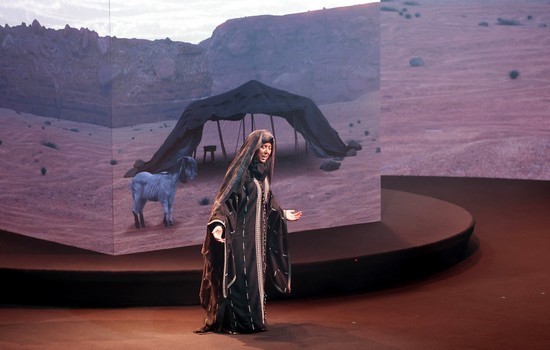DHAHRAN, Saudi Arabia —
A Saudi museum is using filmed reenactments and contemporary artwork to depict
a key episode from Prophet Mohammed’s life that led to the establishment of the
Muslim community.
اضافة اعلان
The exhibition seeks to illustrate — and enliven —
the 1,400-year-old story of the Hijrah, when Prophet Mohammed, threatened with
assassination, undertook an eight-day, 400km migration from Mecca to Medina.
Opened to the public this week, it will be housed
for nine months at the Ithra Museum in the eastern city of Dhahran before
touring domestically and then abroad.
Most Muslims know the Hijrah story in broad strokes,
though never has it been presented in such an immersive way, according to Saudi
scholar Abdullah Hussein Alkadi.
It incorporates everything from centuries-old
artefacts to modern-day drone footage, said Alkadi, who has spent decades
studying the Hijrah and whose research formed the foundation of the exhibition.
 An artist performs a scene about the 1,400-year-old story of the Hijrah, Prophet Mohammed’s migration from Mecca to Medina, at the Ithra Museum in the eastern Saudi city of Dhahran, on July 30, 2022.
An artist performs a scene about the 1,400-year-old story of the Hijrah, Prophet Mohammed’s migration from Mecca to Medina, at the Ithra Museum in the eastern Saudi city of Dhahran, on July 30, 2022.
Ordinary Saudis “know that the Prophet migrated from
Mecca to Medina — that’s it,” Alkadi said, lamenting that the material was not
thoroughly covered in schools.
It should be equally eye-opening for non-Muslims who
might not know the story at all, conveying messages — like the need for
tolerance towards migrants — that are relatable for everyone, Alkadi said.
“You have to have tolerance. If you don’t have
tolerance with all types of people — regardless of their religion, regardless
of their ethnicity, regardless of their gender or whatever — no way can you
live a peaceful life,” he said.
Three years in the making, the exhibition features
work by academics and artists from 20 countries.

Short films by American director Ovidio Salazar
depict how elders from the Quraysh tribe plotted to kill the Prophet Mohammed,
prompting him to flee, and an encounter with the bounty hunter Suraqah, who was
offered 100 camels to return the Prophet dead or alive.
Museum-goers will also see a life-size replica of
the Prophet’s cherished camel Qaswa, contemporary photographs from the Hijrah
route and textiles from the Prophet’s Mosque in Medina.
Other elements
are more interpretive, notably a piece by Saudi artist Zahra Al-Ghamdi, whose
works have previously shown at the Venice Biennale and the British Museum.
For the Hijrah exhibition, Ghamdi spent five months
dipping pieces of fabric in mud and clay and knotting them together.
The knots, displayed against a white backdrop, are
meant to signify the bonds between the residents of Medina and Prophet Mohammed
and his followers.
“Through this work, I am making an appeal to revive
and bring to life this concept of brotherhood, which gives meaning to life,”
she said.
Read more Trending
Jordan News



